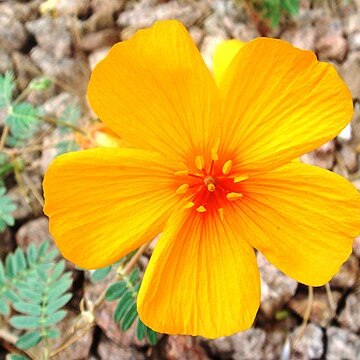Annual or occasionally perennial herbs; stems herbaceous to suffrutescent, diffusely branched, prostrate to decumbent o'r ascending, terete, somewhat suc-culent, becoming striate on drying, densely pubescent to glabrate, spreading radially from a central tap root to 1 m or more long. Leaves opposite, elliptical to broadly obovate, abruptly even-pinnate, one of each pair alternately smaller or sometimes abortive; leaflets 2-10 pairs, opposite, entire, subsessile, elliptical to broadly oblong or obovate, somewhat unequal in size, those on one side of rachis slightly smaller, lowest pair markedly unequal, terminal pair pointed forward and more falcate, pubescent to glabrate; stipules foliaceous. Flowers solitary, pseudaxil-lary, regular; peduncles emerging from axils of alternately smaller leaves; sepals 5(-6), free, pubescent, persistent or rarely caducous; petals 5(-6), white to bright orange, the base same or green to red, free, spreading hemispherically, fugaceous, usually marcescent, convolute; disc fleshy, annular, obscurely 10(-12)-lobed; stamens 10(-12), 5(-6) opposite petals exterior, somewhat longer, and adnate basally to petals, 5(-6) opposite sepals subtended to exterior by a small bibbed gland, the filaments filiform, subulate, or rarely basally winged, unappendaged, inserted on disc, the anthers globose or ovoid to linear-oblong or rarely linear, those opposite sepals rarelv aborting; ovary sessile, 10 (-12)-lobed and-loculed, globose or
ovoid or occasionally conical or pyramidal, glabrous to pubescent, the ovules 1 per locule, pendulous, placentation axile, sometimes 1 or more aborting, the style sim-ple, cylindrical to broadly conical, more or less 10(-12)-ridged, persisting to form a beak on fruit, the stigma capitate, oblong, or clavate, 10(-12)-ridged or-lobed, papillose or rarely coarsely canescent, terminal or rarely extending down almost to base of style. Fruit 10(-12)-lobed, ovoid, occasionally conical, or rarely pyra-midal, glabrous or pubescent, at maturity dividing septicidally and separating from a persistent styliferous axis into 10 (-12) or occasionally fewer mericarps; mericarps 1-loculed, 1-seeded, obliquely triangular, wedge-shaped, more or less tuberculate or rugose abaxially; seeds oblong-ovoid, obliquely pendulous, the testa membranaceous, the embyro straight, endosperm absent.
Sep persistent under the fr; ovary 10-locellar; style accrescent and forming a columnar beak at maturity; fr separating into 10 1-seeded, half-carpellary mericarps, these tuberculate on the back; germination epigeal; diffusely branched, prostrate to ascending herbs allied to Tribulus. 17, New World, mainly trop. and subtrop.

